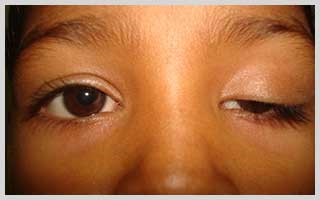- Phone : 0863-2220028
- Opening Hours : 08:00AM to 6:30PM

Menu

AMBLYOPIA is when vision in one eye or both eyes does not develop properly during childhood it is sometimes called lazy eye. Amblyopia is a common problem in babies and younger children
A child’s vision develops in the first few years of life. It is important to diagnose the and treat amblyopia as early as possible. Otherwise, a child with amblyopia will not develop normal healthy vision.
WHAT IS THE CAUSE OF LAZY EYE?
Amblyopia can develop due to other eye and vision problems. Some conditions that may cause amblyopia in a child.

Child with strabismus (squint)
Strabismus is when the eyes point in two different directions. One eye may be focused straight ahead while the other turns in, out, up, or down. To avoid seeing double, the child’s brain may ignore the image from the eye that is not focused straight ahead. As the signal is ignored by the brain, that eye does not develop properly leading to amblyopia.
REFRACTIVE ERRORS
Having a refractive error means being near-sighted, far-sighted, or having astigmatism (distorted or blurred vision). A child may have a refractive error that is worse in one eye. That eye can “turn off”, and vision will not develop properly. The child or parents may not be aware of it since the child’s vision seems fine when using both eyes.

Child with cataract
Some children some children are born with a cataract, where the eyes normal clear lens is cloudy. This can keep vision from developing properly in that eye.

Child with Ptosis in the left eye
Ptosis or a droopy upper lid can block vision in a child’s developing eye and lead to amblyopia or lazy eye.
AMBLYOPIA DIAGNOSIS
Ophthalmologist diagnose amblyopia by checking to see if vision differs between the two eyes. To check a baby’s or young child’s vision, the ophthalmologist may cover one of the child’s eyes and watch how well they can follow a moving object. The doctor may also watch how the child reacts when one eye is covered. If one eye has amblyopia and the other good eye is covered, the child may try to look above or below the patch, pull it off or cry.
The ophthalmologist will do a complete medical eye exam, looking for other eye problems that could be affecting vision leading to amblyopia.
WHEN SHOULD A CHILD’S VISION BE TESTED?
All children who are born with normal weight and apparently healthy otherwise should have their vision checked by their paediatrician, family physician, or ophthalmologist at or before entering pre-K or kindergarten.
Some children need earlier eye checkup if there is a family history of misaligned eyes, childhood cataracts or serious eye diseases in the family. Ideally an ophthalmologist should check their eyes when they are an infant. Premature babies with low birth weight need eye checkup immediately after birth.
Most doctors test vision as part of a child’s medical exam. If they see any sign of eye problems, they may send a child to an ophthalmologist for further tests.
AMBLYOPIA TREATMENT
AMBLYOPIA IS USUALLY CORRECTED BY MAKING THE CHILD USE THEIR WEAKER EYE. This is often done by putting a patch over the child’s stronger eye. In some cases, eye drops can be used to blur vision in the stronger eye. Or the child may wear eyeglasses with a lens that blurs vision in that eye.
It generally takes several weeks to several months for vision to get stronger in a weaker eye. Once the child has better vision in that eye, then we need to wear an eye patch part-time for a few years. This helps keep their vision strong. Remember to keep all appointments with the child’s Ophthalmologist who will carefully monitor your child’s vision.
HOW TO CHOOSE AND USE AN EYE PATCH?
An eye patch should be comfortable, yet remain firmly in place. It should not allow the child to peak around its edges. Most drug stores have a variety of sizes and types of eye patches. Decorated fun patches are available online. Do not use the black eye patches with elastic bands or ties (such as a pirate-type patches). These are too easy for a child to remove or peak around. To wear the patch, simply attach it to the skin around your child’s eye.
If your child wears glasses, there are patches designed to attach to the lens. These may be good for children who are used to wearing a patch, but they are not as good for a child’s new to treatment. This is because the patch can slip or the child may learn to peek around it. If your child wears glasses and is not used to patching, it is best to attach the patch directly around the stronger eye underneath the glasses.
KEEP YOUR CHILD FROM TAKING OFF THE EYE PATCH
TEACH YOUR CHILD ABOUT THE EYE PATCH
THINGS TO CONSIDER WITH PATCHING TREATMENT
SURGERY
TREATING AMBLYOPIA USING NEW TECHNOLOGY
A new treatment for amblyopia uses a virtual reality (VR) headset to help improve vision in children aged 4 to 7. A child watches videos wearing the headset, which helps them use their weaker eye. To learn more, ask your child’s ophthalmologist.
TREATING AMBLYOPIA FOR BETTER LIFELONG VISION
When a child has amblyopia, it is important to make vision stronger in the weak eye. It is possible to prevent vision loss from amblyopia. For best results, amblyopia should be treated before a child reaches 7 or 8 years old. Many children do not like to have their stronger eye patched or blurred. However, you need to help your child do what is best for them – Correct causes of amblyopia. Even if eye problems causing amblyopia are corrected with glasses or surgery, the amblyopia itself must be treated. If not, the child may have lifelong vision problems.
Sudarsani Eye Hospital
Sudarsani Eye Hospital
Copyright © 2023. All rights reserved.